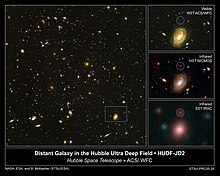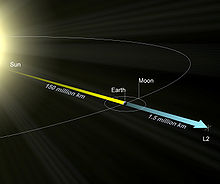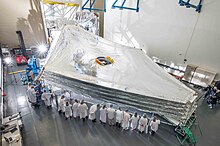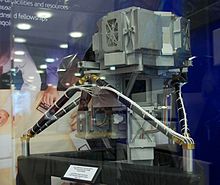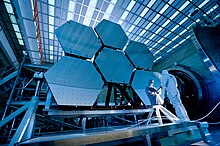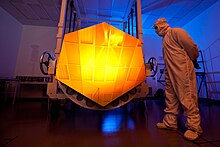From Wikipedia, the free encyclopedia

The full-scale James Webb Space Telescope model at South by Southwest in Austin
|
|
| General information | |
|---|---|
| Organization | NASA,[1] with significant contributions from ESA and CSA |
| Major contractors | Northrop Grumman Ball Aerospace |
| Launch date | October 2018 (planned)[2] |
| Launch site | Guiana Space Centre ELA-3 Kourou, French Guiana |
| Launch vehicle | Ariane 5 (planned) |
| Mission length | 5 years (design) 10 years (goal) |
| Mass | 6,200 kg (13,700 lb) |
| Orbit period | 1 year |
| Location | 1.5 million km from Earth (Earth–Sun Lagrangian point L2 halo orbit) |
| Telescope style | Korsch (Three-mirror anastigmat) |
| Wavelength | 0.6 µm (orange) to 28.5 µm (mid-infrared) |
| Diameter | 6.5 m (21 ft) |
| Collecting area | 25 m2 (270 sq ft) |
| Focal length | 131.4 m (431 ft) |
| Instruments | |
| NIRCam | Near IR Camera |
| NIRSpec | Near-Infrared Spectrograph |
| MIRI | Mid IR Instrument |
| NIRISS | Near Infrared Imager and Slitless Spectrograph |
| FGS | Fine Guidance Sensor |
| Website | NASA United States ESA b Europe CSA/ASC Canada CNES France |
The James Webb Space Telescope (JWST), previously known as Next Generation Space Telescope (NGST), is a planned space observatory scheduled to launch in October 2018. The JWST will offer unprecedented resolution and sensitivity from long-wavelength visible to the mid-infrared, and is a successor instrument to the Hubble Space Telescope and the Spitzer Space Telescope. The telescope features a segmented 6.5-meter (21 ft) diameter primary mirror and will be located near the Earth–Sun L2 point. A large sunshield will keep its mirror and four science instruments below 50 K (−220 °C; −370 °F).
JWST's capabilities will enable a broad range of investigations across the fields of astronomy and cosmology.[3] One particular goal involves observing some of the most distant objects in the Universe, beyond the reach of current ground and space based instruments. This includes the very first stars, the epoch of reionization, and the formation of the first galaxies. Another goal is understanding the formation of stars and planets. This will include imaging molecular clouds and star-forming clusters, studying the debris disks around stars, direct imaging of planets, and spectroscopic examination of planetary transits.
In gestation since 1996,[4] the project represents an international collaboration of about 17 countries[5] led by NASA, and with significant contributions from the European Space Agency and the Canadian Space Agency. It is named after James E. Webb, the second administrator of NASA, who played an integral role in the Apollo program.[6]
The JWST has a history of major cost overruns. In 2011, the United States House of Representatives voted to terminate funding, after about $3 billion had been spent and 75 percent of its hardware was in production.[7] Funding was restored in compromise legislation with the US Senate, and spending on the program was capped at $8 billion.[8] As of December 2014[update], the telescope remained on schedule and within budget, but at risk of delays.[9]
Overview
The JWST originated in 1996 as the Next Generation Space Telescope (NGST). In 2002 it was renamed after NASA's second administrator (1961–1968) James E. Webb (1906–1992), noted for playing a key role in the Apollo program and establishing scientific research as a core NASA activity.[10] The JWST is a project of the National Aeronautics and Space Administration, the United States space agency, with international collaboration from the European Space Agency and the Canadian Space Agency.
The telescope has an expected mass about half of Hubble's, but its primary mirror (a 6.5 meter diameter gold-coated beryllium reflector) will have a collecting area about five times larger (25 m2 vs. 4.5 m2). The JWST is oriented towards near-infrared astronomy, but can also see orange and red visible light, as well as the mid-infrared region, depending on the instrument. The telescope will focus on the near to mid-infrared for three main reasons: high-redshift objects have their visible emissions shifted into the infrared, cold objects such as debris disks and planets emit most strongly in the infrared, and this band is very hard to study from the ground or by existing space telescopes such as Hubble.
The JWST will operate near the Earth-Sun L2 Lagrange point, approximately 1,500,000 kilometres (930,000 mi) beyond the Earth. Objects near this point can orbit the Sun in synchrony with the Earth, allowing the telescope to remain at a roughly constant distance[11] and use a single sunshield to block heat and light from the Sun and Earth. This will keep the temperature of the spacecraft below 50 K (−220 °C; −370 °F), necessary for infrared observations.[12]
Launch is scheduled for 2018 on an Ariane 5 rocket. Its nominal mission length is five years, with a goal of ten years.[13][14] The prime contractor is Northrop Grumman.
Development
Early development work for a Hubble successor between 1989 and 1994 led to the Hi-Z[15] telescope concept, a fully baffled[Note 1] 4-meter aperture infrared telescope going out to 3 AU in its orbit.[16] The distant orbit helped reduce light noise from zodiacal dust.[16] Other early plans called for a NEXUS precursor telescope mission.[17][18]
In the "faster, better, cheaper" era in the mid-1990s, NASA leaders pushed for a low-cost space telescope.[19] The result was the NGST, with an 8 meter aperture and located at L2, estimated to cost $500 million.[19] In 1997, NASA worked with the Goddard Space Flight Center,[20] Ball Aerospace,[21] and TRW[22] to conduct technical requirement and cost studies, and in 1999 selected Lockheed Martin[23] and TRW for preliminary design concepts.[24] In 2002, NASA awarded the $824.8 million prime contract for the NGST, now renamed the James Webb Space Telescope, to TRW. The design called for a 6.1-meter (20 ft) primary mirror and a launch date of 2010.[25] Later that year, TRW would be acquired by Northrop Grumman in a hostile bid and became Northrop Grumman Space Technology/Ball Aerospace.[24]
Comparisons
In contrast to other proposed observatories, most of which have already been canceled or put on hold, including Terrestrial Planet Finder (2011), Space Interferometry Mission (2010), Laser Interferometer Space Antenna (2011), and the International X-ray Observatory (2011), the JWST telescope is the last big NASA astrophysics mission of its generation to be built.The telescope's delays and cost increases can be compared to the Hubble Space Telescope.[26] When it formally started in 1972, what came to be known as Hubble had a then estimated development cost of $300 million (or about $1 billion in 2006 constant dollars),[26] but by the time it was sent into orbit in 1990, cost about four times that.[26] In addition, new instruments and servicing missions increased the cost to at least $9 billion by 2006.[26]
A 2006 article in the journal Nature noted a study in 1984 by the Space Science Board, which estimated that a next generation infrared observatory would cost $4 billion (about $7 billion in 2006 dollars).[26]
Other major telescope concepts that have either been canceled, studied, or are not approaching launch include MAXIM (Microarcsecond X-ray Imaging Mission), SAFIR (Single Aperture Far-Infrared Observatory), SUVO (Space Ultraviolet-Visible Observatory), SPECS (Submillimeter Probe of the Evolution of Cosmic Structure), and the aforementioned canceled TPF, SIM, LISA, and IXO.
Mission

Two alternate Hubble Space Telescope views of the Carina Nebula, comparing visible (top) and infrared (bottom) astronomy
The JWST's primary scientific mission has four main components: to search for light from the first stars and galaxies that formed in the Universe after the Big Bang, to study the formation and evolution of galaxies, to understand the formation of stars and planetary systems and to study planetary systems and the origins of life.[27] These goals can be accomplished more effectively by observation in near-infrared light rather than light in the visible part of the spectrum. For this reason the JWST's instruments will not measure visible or ultraviolet light like the Hubble Telescope, but will have a much greater capacity to perform infrared astronomy. The JWST will be sensitive to a range of wavelengths from 0.6 (orange light) to 28 micrometers (deep infrared radiation at about 100 K (−170 °C; −280 °F)).
Infrared astronomy
JWST is the formal successor to the Hubble Space Telescope (HST), and since its primary emphasis is on infrared observation, it is also a successor to the Spitzer Space Telescope. JWST will far surpass both those telescopes, being able to see many more and much older stars and galaxies.[28] Observing in the infrared is a key technique for achieving this, because it better penetrates obscuring dust and gas, allows observation of dim cooler objects, and because of cosmological redshift. Since water vapor and carbon dioxide in the Earth's atmosphere strongly absorbs most infrared, ground-based infrared astronomy is limited to narrow wavelength ranges where the atmosphere absorbs less strongly. Additionally, the atmosphere itself radiates in the infrared, often overwhelming light from the object being observed. This makes space the ideal place for infrared observation.[29]The distant universe: The more distant an object is, the younger it appears: its light has taken longer to reach us. Because the universe is expanding, as the light travels it becomes red-shifted, and these objects are therefore easier to see if viewed in the infrared.[30] JWST's infrared capabilities are expected to let it see all the way to the very first galaxies forming just a few hundred million years after the Big Bang.[31]
Dust penetration: Infrared radiation is better able to pass freely through dusty regions of space that scatter radiation in the visible spectrum. These two images of the Carina Nebula (left margin) were taken with the HST. The top image was photographed utilizing the visible spectrum whereas the bottom image was taken in the infrared using the HST's WFC3 upgrade. Many more stars can be counted in the infrared image than in the visible light image. Observations in infrared allow the study of objects and regions of space which would be obscured by gas and dust in the visible spectrum,[30] such as the molecular clouds where stars are born, the circumstellar disks that give rise to planets, and the cores of active galaxies.[30]
Cool objects: Relatively cool objects (temperatures less than several thousand degrees) emit their radiation primarily in the infrared, as described by Planck's law. As a result, most objects that are cooler than stars are better studied in the infrared. This includes the clouds of the interstellar medium, the "failed stars" called brown dwarfs, planets both in our own and other solar systems, and comets and Kuiper belt objects.
Orbit
Since the telescope will be so far from Earth (around four times as far away as the Moon), its instruments have not been designed for in-orbit servicing. Nevertheless, the JWST will be equipped with a docking ring so as to not preclude a visit by robotic or crewed spacecraft such as the Orion MPCV for minimal tasks, such as releasing a stuck antenna or solar panel.[35]
Sunshield protection
In order to make observations in the infrared spectrum, the JWST must be kept very cold (under 50 K (−220 °C; −370 °F)), otherwise infrared radiation from the telescope itself would swamp its instruments. Therefore it uses a large sunshield to block light and heat from the Sun, Earth, and Moon, and its position near the Earth-Sun L2 point keeps all three bodies on the same side of the spacecraft at all times.[36] Its halo orbit around L2 avoids the shadow of the Earth and Moon, maintaining a constant environment for the sunshield and solar arrays.[11] The sunshield is made of polyimide film, has membranes coated with aluminum on one side and silicon on the other.
The sunshield is designed to be folded twelve times so it will fit within the Ariane 5 rocket's 4.57 m × 16.19 m shroud. Once deployed at the L2 point, it will unfold to 12.2 m × 18 m. The sunshield was hand-assembled at Man Tech (NeXolve) in Huntsville, Alabama before it was delivered to Northrop Grumman in Redondo Beach, California for testing.[37]
Optics and instruments
Optical design
JWST's primary mirror is a 6.5-meter-diameter gold-coated beryllium reflector with a collecting area of 25 m2. This is too large for contemporary launch vehicles, so the mirror is composed of 18 hexagonal segments, which will unfold after the telescope is launched. Image plane wavefront sensing through phase retrieval will be used to position the mirror segments in the correct location using very precise micro-motors. Subsequent to this initial configuration they will only need occasional updates every few days to retain optimal focus.[38] This is unlike terrestrial telescopes like the Keck which continually adjust their mirror segments using active optics to overcome the effects of gravitational and wind loading, and is made possible because of the lack of environmental disturbances of a telescope in space.JWST's optical design is a three-mirror anastigmat,[39] which makes use of curved secondary and tertiary mirrors to deliver images that are free of optical aberrations over a wide field. In addition, there is a fast steering mirror, which can adjust its position many times a second to provide image stabilization.
Ball Aerospace & Technologies Corp. is the principal optical subcontractor for the JWST program, led by prime contractor Northrop Grumman Aerospace Systems, under a contract from the NASA Goddard Space Flight Center, in Greenbelt, Maryland.[40] Eighteen primary mirror segments, secondary, tertiary and fine steering mirrors, plus flight spares have been fabricated and polished by Ball Aerospace based on beryllium segment blanks manufactured by several companies including Axsys, Brush Wellman, and Tinsley Laboratories. As of June 2011, the first set of six fully completed mirror segments, including rigid supporting frames and cryogenic actuators, was undergoing final testing at NASA Marshall Space Flight Center, and testing all of the remaining mirrors was completed by December 2011, two months ahead of schedule.[41]
Scientific instruments
The Integrated Science Instrument Module (ISIM) contains four science instruments and a guide camera.[42]- Near InfraRed Camera (NIRCam) is an infrared imager which will have a spectral coverage ranging from the edge of the visible (0.6 micrometers) through the near infrared (5 micrometers).[43][44][45] NIRCam will also serve as the observatory's wavefront sensor, which is required for wavefront sensing and control activities. NIRCam is being built by a team led by the University of Arizona, with Principal Investigator Marcia Rieke. The industrial partner is Lockheed-Martin's Advanced Technology Center located in Palo Alto, California.[46]
- Near InfraRed Spectrograph (NIRSpec) will also perform spectroscopy over the same wavelength range. It is being built by the European Space Agency at ESTEC in Noordwijk, Netherlands. The leading development team is composed of people from Astrium, Ottobrunn and Friedrichshafen, Germany, and the Goddard Space Flight Center; with Pierre Ferruit as NIRSpec project scientist. The NIRSpec design provides 3 observing modes: a low-resolution mode using a prism, an R~1000 multi-object mode and an R~2700 integral field unit or long-slit spectroscopy mode.[47] Switching of the modes is done by operating a wavelength preselection mechanism called the Filter Wheel Assembly, and selecting a corresponding dispersive element (prism or grating) using the Grating Wheel Assembly mechanism. Both mechanisms are based on the successful ISOPHOT wheel mechanisms of the Infrared Space Observatory. The multi-object mode relies on a complex micro-shutter mechanism to allow for simultaneous observations of hundreds of individual objects anywhere in NIRSpec's field of view. The mechanisms and their optical elements are being designed,[48] integrated and tested by Carl Zeiss Optronics GmbH of Oberkochen, Germany, under contract from Astrium.[49]
- Mid-Infrared Instrument (MIRI) will measure the mid-infrared wavelength range from 5 to 27 micrometers. It contains both a mid-IR camera and an imaging spectrometer.[50] MIRI is being developed as a collaboration between NASA and a consortium of European countries, and is led by George Rieke (University of Arizona) and Gillian Wright (UK Astronomy Technology Centre, Edinburgh, part of the Science and Technology Facilities Council (STFC)).[46] MIRI features similar wheel mechanisms as NIRSpec which are also developed and built by Carl Zeiss Optronics GmbH under contract from the Max Planck Institute for Astronomy, Heidelberg.[51][52][53] The completed Optical Bench Assembly of MIRI was delivered to Goddard in mid-2012 for eventual integration into the ISIM.
- Fine Guidance Sensor (FGS), led by the Canadian Space Agency under project scientist John Hutchings (Herzberg Institute of Astrophysics, National Research Council of Canada), is used to stabilize the line-of-sight of the observatory during science observations. Measurements by the FGS are used both to control the overall orientation of the spacecraft and to drive the fine steering mirror for image stabilization. The Canadian Space Agency is also providing a Near Infrared Imager and Slitless Spectrograph (NIRISS) module for astronomical imaging and spectroscopy in the 0.8 to 5 micrometer wavelength range, led by principal investigator René Doyon at the University of Montreal.[46] Because the NIRISS is physically mounted together with the FGS, they are often referred to as a single unit, but they serve entirely different purposes, with one being a scientific instrument and the other being a part of the observatory's support infrastructure.
The infrared detectors for the NIRCam, NIRSpec, FGS, and NIRISS modules are being provided by Teledyne Imaging Sensors (formerly Rockwell Scientific Company).
The James Webb Space Telescope (JWST) Integrated Science Instrument Module (ISIM) and Command and Data Handling (ICDH) engineering team uses SpaceWire to send data between the science instruments and the data-handling equipment.[54]
Construction and engineering
Primary mirror segments made of beryllium
Mirror segments undergoing cryogenic tests at the X-ray & Cryogenic Facility at Marshall Space Flight Center
Mirror segment after being coated with gold
NASA's Goddard Space Flight Center in Greenbelt, Maryland, is leading the management of the observatory project. The project scientist for the James Webb Space Telescope is John C. Mather. Northrop Grumman Aerospace Systems serves as the primary contractor for the development and integration of the observatory. They are responsible for developing and building the spacecraft element, which includes both the spacecraft bus and sunshield. Ball Aerospace has been subcontracted to develop and build the Optical Telescope Element (OTE). Northrop Grumman's Astro Aerospace business unit has been contracted to build the Deployable Tower Assembly (DTA) which connects the OTE to the spacecraft bus[55] and the Mid Boom Assembly (MBA) which helps to deploy the large sunshields on orbit.[56] Goddard Space Flight Center is also responsible for providing the Integrated Science Instrument Module (ISIM).[40]
The observatory attaches to the Ariane 5 rocket via a launch vehicle adapter ring which could be used by a future spacecraft to grapple the observatory to attempt to fix gross deployment problems. However, the telescope itself is not serviceable, and astronauts would not be able to perform tasks such as swapping instruments, as with the Hubble Telescope.
Most of the data processing on the telescope is done by conventional single-board computers.[57] The conversion of the analog science data to digital form is performed by the custom-built SIDECAR ASIC (System for Image Digitization, Enhancement, Control And Retrieval Application Specific Integrated Circuit). It is said[by whom?] that the SIDECAR ASIC will include all the functions of a 20-pound (9.1 kg) instrument box in a package the size of a half-dollar[quantify], and consume only 11 milliwatts of power. Since this conversion must be done close to the detectors, on the cool side of the telescope, the low power use of this IC will be crucial for maintaining the low temperature required for optimal operation of the JWST.[58]
Ground support and operations
The Space Telescope Science Institute (STScI) in Baltimore, Maryland has been selected as the Science and Operations Center (S&OC) for JWST. In this capacity, STScI will be responsible for the scientific operation of the telescope and delivery of data products to the astronomical community.[59] Data will be transmitted from JWST to the ground via NASA's Deep Space Network, processed and calibrated at STScI, and then distributed online to astronomers worldwide. Similar to how Hubble is operated, anyone, anywhere in the world, will be allowed to submit proposals for observations. Each year several committees of astronomers will peer review the submitted proposals to select the programs to observe in the coming year. The authors of the chosen proposals will typically have one year of private access to the new observations, after which the data will become publicly available for download by anyone from the online archive at STScI.Program status

NASA, space science industry, and government officials, with a full-size telescope model at Maryland Science Center in Baltimore.
A review of the program released in August 2011, said the cost for the telescope and 5 years of operations will be $8.7 billion with a planned launch in 2018.[60] Of that price about $800 million is for the five years of operations.[61][62] The Webb will be launched from Arianespace's ELA-3 launch complex at European Spaceport located near Kourou, French Guiana. The planned launch vehicle is an Ariane 5 ECA with a cryogenic upper stage.[63][dated info]
History of the program
Cost growth revealed in spring 2005[when?] led to an August 2005 re-planning.[64] The primary technical outcomes of the re-planning were significant changes in the integration and test plans, a 22-month launch delay (from 2011 to 2013), and elimination of system-level testing for observatory modes at wavelength shorter than 1.7 micrometers. Other major features of the observatory were unchanged. Following the re-planning, the program was independently reviewed in April 2006. The review concluded the program was technically sound, but that funding phasing at NASA needed to be changed. NASA re-phased its JWST budgets accordingly.In the 2005 re-plan, the life-cycle cost of the project was estimated at about US$4.5 billion. This comprised approximately US$3.5 billion for design, development, launch and commissioning, and approximately US$1.0 billion for ten years of operations.[64] ESA is contributing about €300 million, including the launch,[65] and the Canadian Space Agency about $39M Canadian.[66] As of May 2007[update] costs were still on target.[67]
| Year | Events |
|---|---|
| 1996 | NGST started |
| 2002 | named JWST, 8 to 6 m |
| 2004 | NEXUS cancelled[68] |
| 2007 | esa/nasa MOU |
| 2010 | MCDR passed |
| 2011 | Proposed cancel |
In January 2007, nine of the ten technology development items in the program successfully passed a non-advocate review.[69] These technologies were deemed sufficiently mature to retire significant risks in the program. The remaining technology development item (the MIRI cryocooler) completed its technology maturation milestone in April 2007. This technology review represented the beginning step in the process that ultimately moved the program into its detailed design phase (Phase C).
In March 2008, the project successfully completed its Preliminary Design Review (PDR). In April 2008, the project passed the Non-Advocate Review. Other passed reviews include the Integrated Science Instrument Module review in March 2009, the Optical Telescope Element review completed in October 2009, and the Sunshield review completed in January 2010.
In April 2010, the telescope passed the technical portion of its Mission Critical Design Review (MCDR). Passing the MCDR signified the integrated observatory will meet all science and engineering requirements for its mission.[70] The MCDR encompassed all previous design reviews. The project schedule underwent review during the months following the MCDR, in a process called the Independent Comprehensive Review Panel, which led to a re-plan of the mission aiming for 2015, but as late as 2018. By 2010 cost over-runs were impacting other programs, though JWST itself remained on schedule.[71]
By 2011, the JWST program was in the final design and fabrication phase (Phase C). As is typical for a complex design that cannot be changed once launched, there are detailed reviews of every portion of design, construction, and proposed operation. New technological frontiers have been pioneered by the program, and it has passed its design reviews. In the 1990s it was unknown if a telescope so large and light was possible.[72]
In April 2011, cryogenic testing of a six-mirror array began. This test is to ensure the mirrors perform to specifications at the temperatures they will encounter.[73]
On June 16, 2014, the ISIM or Integrated Science Instrument Module of the JWST was lowered by a 30-ft cable into Goddard's Space Environment Simulator for a four-month-long thermal vacuum test.[74]
Even with the funding for the telescope secured, the program status remains controversial while the telescope components are being completed.[75]
Reported cost and schedule issues
| Year | Launch | Budget Plan |
|---|---|---|
| 1997 | 2007[72] | 0.5 Billion USD[72] |
| 1998 | 2007[76] | 1[26] |
| 1999 | 2007 to 2008[77] | 1[26] |
| 2000 | 2009[78] | 1.8[26] |
| 2002 | 2010[79] | 2.5[26] |
| 2003 | 2011[80] | 2.5[26] |
| 2005 | 2013 | 3[81] |
| 2006 | 2014 | 4.5[82] |
| 2008 | 2014 | 5.1[61] |
| 2010 | 2015 to 2016 | 6.5 |
| 2011 | 2018 | 8.7[60] |
| 2013 | 2018 | 8.8 |
| Year | Cost (billion USD) |
|---|---|
| 1997 | |
| 1998 | |
| 1999 | |
| 2000 | |
| 2002 | |
| 2003 | |
| 2005 | |
| 2006 | |
| 2008 | |
| 2010 | |
| 2011 | |
| 2013 |
Some scientists have expressed concerns about growing costs and schedule delays for the Webb telescope, which competes for scant astronomy budgets and thus threatens funding for other space science programs. A review of NASA budget records and status reports by journalists at Florida Today show the Webb observatory is plagued by many of the same problems that have plagued several other major NASA projects. Mistakes included: underestimates of the telescope’s cost that failed to budget for expected technical glitches, and failure to act on warnings that budgets were being exceeded, thus extending the schedule and increasing costs further.[84]
Proposed U.S. withdrawal[edit]
On 6 July 2011, the United States House of Representatives' appropriations committee on Commerce, Justice, and Science moved to cancel the James Webb project by proposing an FY2012 budget that removed $1.9bn from NASA's overall budget, of which roughly one quarter was for JWST.[85][86][87][88] This budget proposal was approved by subcommittee vote the following day; however, in November 2011, Congress reversed plans to cancel the JWST and instead capped additional funding to complete the project at $8 billion.The committee charged that the project was "billions of dollars over budget and plagued by poor management". The telescope was originally estimated to cost $1.6bn but the cost estimate grew throughout the early development reaching about $5bn by the time the mission was formally confirmed for construction start in 2008. In summer 2010, the mission passed its Critical Design Review with excellent grades on all technical matters, but schedule and cost slips at that time prompted US Senator Barbara Mikulski to call for an independent review of the project. The Independent Comprehensive Review Panel (ICRP) chaired by J. Casani (JPL) found that the earliest launch date was in late 2015 at an extra cost of $1.5bn (for a total of $6.5bn). They also pointed out that this would have required extra funding in FY2011 and FY2012 and that any later launch date would lead to a higher total cost.[89] Because the runaway budget diverted funding from other research, the science journal Nature described the James Webb as "the telescope that ate astronomy".[90] However, termination of the project as proposed by the House appropriation committee would not have provided funding to other missions, as the JWST line would have been terminated with the funding leaving astrophysics (and the NASA budget) entirely.[citation needed]
The American Astronomical Society issued a statement in support of JWST in 2011,[91] as did Maryland US Senator Barbara Mikulski.[92] A number of editorials supporting JWST appeared in the international press during 2011 as well.[85][93][94]
Public displays and outreach
A large telescope model has been on display at various places since 2005: in the United States at Seattle, Washington; Colorado Springs, Colorado; Greenbelt, Maryland; Rochester, New York; Manhattan, New York; and Orlando, Florida; and elsewehere at Paris, France; Dublin, Ireland; Montreal, Canada; Hatfield, United Kingdom; and Munich, Germany. The model was built by the main contractor, Northrop Grumman Aerospace Systems.[95]
In May 2007, a full-scale model of the telescope was assembled for display at the Smithsonian Institution's National Air and Space Museum on the National Mall, Washington D.C. The model was intended to give the viewing public a better understanding of the size, scale and complexity of the satellite, as well as pique the interest of viewers in science and astronomy in general. The model is significantly different from the telescope, as the model must withstand gravity and weather, so is constructed mainly of aluminum and steel measuring approximately 24×12×12 m (79×39×39 ft) and weighs 5.5 tonnes (12,000 lb).
The model was on display in New York City's Battery Park during the 2010 World Science Festival, where it served as the backdrop for a panel discussion featuring Nobel Prize laureate John C. Mather, astronaut John M. Grunsfeld and astronomer Heidi Hammel. In March 2013, the model was on display in Austin, Texas for SXSW 2013.[96][97]
Images
Partnership
NASA, ESA and CSA have collaborated on the telescope since 1996. ESA's participation in construction and launch was approved by its members in 2003 and an agreement was signed between ESA and NASA in 2007. In exchange for full partnership, representation and access to the observatory for its astronomers, ESA is providing the NIRSpec instrument, the Optical Bench Assembly of the MIRI instrument, an Ariane-5 ECA launcher, and manpower to support operations.[65][98] The CSA will provide the Fine Guidance Sensor and the Near-Infrared Imager Slitless Spectrograph[99] plus manpower to support operations.- Participating countries


